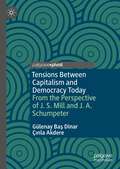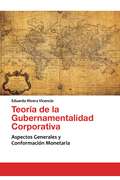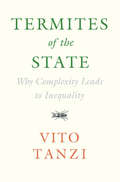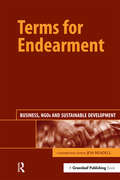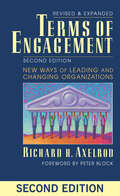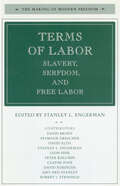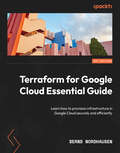- Table View
- List View
Tennant Company
by James Weber Lynda M. Applegate Toby StuartTennant, a leading producer of floor cleaning equipment, must determine how to create, finance, structure, staff, govern, measure and manage a new venture for developing a fundamentally new product line. In 2005, Tennant Company had developed an innovative, environmentally friendly, cleaning technology that could potentially revolutionize cleaning. Historically, Tennant was a producer of floor and carpet washing machines for industrial and commercial markets. Over time, it became clear that the technology had applications far beyond Tennant's core markets. In mid-2009, the company set up a new venture to develop the technology's promise. In 2010 this venture was wholly owned by Tennant and run by a Tennant manager. The case examines the decisions the CEO and new venture head must make to best structure and position the venture to succeed.
Tennant Company: Innovating Within and Beyond the Core
by James Weber Lynda M. Applegate Toby StuartTennant, a leading producer of floor cleaning equipment, must determine the business model to use for its new chemical free cleaning technology. In 2005, Tennant Company had developed an innovative, environmentally friendly, cleaning technology that could potentially revolutionize cleaning. Historically, Tennant was a producer of floor and carpet washing machines for industrial and commercial markets. Over time, it became clear that the technology had applications far beyond Tennant's core markets. In mid-2009, the company set up a new venture to develop the technology's promise. In 2010 this venture was wholly owned by Tennant and run by a Tennant manager. The case examines the decisions the CEO and new venture head must make to best structure and position the venture to succeed.
Tensions Between Capitalism and Democracy Today From the Perspective of J. S. Mill and J. A. Schumpeter
by Çınla Akdere Gülenay Baş DinarThis book examines the intellectual ideas that underpin our understanding of capitalism. Framing these debates through the work on John Stuart Mill and Joseph Schumpeter, the development of democracy and its relationship with capitalism is explored to provide insight into the rationality of individuals and the distribution of power. By analysing the evolution of economic systems, ideas relating to democracy, capitalism, liberalism, competition, and elites are also defined.This book aims to inform current economic and political debates and to highlight new forms of democracy and capitalism. It will be relevant to students and researchers interested in the political economy and the history of economic thought.
Tensions at SearchLight Cures
by Laura Huang Sarah MehtaThis general experience case tells the story of SearchLight Cures, a fictional biotechnology startup. Having discovered a new therapy for a rare disease, the company's co-founders find themselves at an impasse over a pricing disagreement.
Tensions of Organization Design: Optimizing Trade-offs
by Robert L. SimonsTo be fully effective, all managers must understand the implications of the organization design choices on their business units. This chapter makes the case for the development of a new theory of organization design by reviewing the tensions that today's managers must navigate to succeed in designing or redesigning organizations for enduring performance.
Teoria della Probabilità: Variabili aleatorie e distribuzioni (UNITEXT #123)
by Andrea PascucciIl libro fornisce un'introduzione concisa ma rigorosa alla Teoria della Probabilità. Fra i possibili approcci alla materia si è scelto quello più moderno, basato sulla teoria della misura: pur richiedendo un grado di astrazione e sofisticazione matematica maggiore, esso è indispensabile a fornire le basi per lo studio di argomenti più avanzati come i processi stocastici, il calcolo differenziale stocastico e l'inferenza statistica. Nato dall'esperienza di insegnamento del corso di Probabilità e Statistica Matematica presso la Laurea Triennale in Matematica dell'Università di Bologna, il testo raccoglie materiale per un insegnamento semestrale in corsi di studio scientifici (Matematica, Fisica, Ingegneria, Statistica...), assumendo come prerequisito il calcolo differenziale e integrale di funzioni di più variabili. I quattro capitoli del libro trattano i seguenti argomenti: misure e spazi di probabilità; variabili aleatorie; successioni di variabili aleatorie e teoremi limite; attesa e distribuzione condizionata. Il testo include una raccolta di esercizi risolti.
Teoría de la Gubernamentalidad Corporativa: Aspectos generales y conformación monetaria
by Eduardo Rivera VicencioRecomendable para todo tipo de público Imprescindible para todas las personas que trabajan en el sector público y en la política Fundamental para los empresarios de la economía real, directivos, los profesionales del área económica y docentes. <P><P>Teoría de la gubernamentalidad corporativa es recomendable para todo tipo de público interesado en conocer la realidad de la economía y sus crisis, es imprescindible para todas las personas que trabajan en el sector público y en la política, y es fundamental para los empresarios de la economía real, directivos y los profesionales del área económica. <P><P>La primera parte corresponde al respaldo teórico para aquellos que quieran profundizar en el tema, la segunda parte describe los aspectos generales de esta teoría y en la tercera parte se hace una descripción histórica y económica de la conformación monetaria, que ha permitido la concentración de la riqueza, la apropiación de las rentas y de sus rendimientos. <P><P>Esta teoría tiene como hilo conductor la metodología de Michel Foucault histórica y filosófica (arqueológica y genealógica), con la argumentación y respaldo teórico económico, junto a las manifestaciones de las relaciones de poder, como el discurso, la disciplina, la ética y la gubernamentalidad. <P><P>Este libro describe la conformación del homo economicus, de la empresa y de los primeros bancos centrales, hasta el sistema de dinero-deuda actual, como herramientas de dominación.
Tequila Patr n
by Rohit Deshpande Fernanda Miguel Carlos Castellanos Rodriguez Samantha Rullan Silvia Cacho-ElizondoTequila Patr n was one of the most successful tequila marketers in the United States. Patr n needed to grow and in Mexico, the second largest market for tequila, the brand was perceived as American. What portfolio and branding strategy would best serve Patr n to conquer the Mexican market? Furthermore, what would expanding in Mexico imply for the company's marketing operations?
Teradyne Corp.: The Jaguar Project
by Gary P. Pisano Francesca GinoTeradyne, a leading manufacturer of semiconductor test equipment, embarked on a multiyear effort to improve its product development capabilities and to implement more formalized project management approaches. Examines the development of a new-generation tester that involved significant hardware and software design. For this, the company decided to implement new approaches to project management and project teams. Invites discussion of the effectiveness of these approaches and the general lessons for the management of product development.
Teradyne: The Aurora Project
by Joseph L. BowerThree cases deal with the introduction of a new product to Teradyne's line of semiconductor test equipment. Teradyne: Managing Strategic Change provides historic and administrative background for the other two cases. This case deals with the problems facing the head of a start-up division responsible for developing and bringing to market a new product based on technology deemed very important to the future but unattractive to present customers and, therefore, the operating divisions. This revision is shorter and provides a simpler description of the technology involved. Teradyne: Managing Disruptive Change deals with the same set of problems from the perspective of corporate management--in particular why the skunk works approach was necessary and what new problems this approach creates even if the project is successful.
Term Sheet Negotiations for Trendsetter, Inc.
by William J. Coughlin Walter KuemmerleDescribes two aspiring entrepreneurs who have just received offering documents for venture funding (known as term sheets) from two venture capital firms. Neither of the entrepreneurs have experience in raising capital and they are wondering how to compare the two proposals and which one to choose. They need to make a decision fast. The documents contain two complete term sheets which are similar in structure but different in important ways. Both term sheets have advantages and disadvantages for the entrepreneurs. Choosing one over the other requires a careful analysis as well as a certain set of assumptions about the growth of Trendsetter, Inc.
Termites and Sustainable Management: Volume 1 - Biology, Social Behaviour and Economic Importance (Sustainability in Plant and Crop Protection)
by Md. Aslam Khan Wasim AhmadThis Volume comprises 12 chapters in an attempt to bring available information on biology, social behavour and economic importance of termites. Chapters in this book dealing with termites identification provide a review on most updated information of their systematics. Ecologically, termites interact with living and non-living surroundings and deliver a wide range of behaviors. In a separate chapter termites ecology is examined and explored. Termites depend on their gut microbes for digestion of complex polysaccharides of wood into simpler molecules. Information provided on termite gut microbiome and lignocellulose degradation constitutes an important contribution. Termite biology and social behaviour have been addressed comprehensively. Trail pheromones are responsible for the orientation and recruitment of nestmates to the food sources. Once arriving at a potential food source, termites assess its quality using a different set of cues. A separate chapter on trail pheromones, cues used during foraging and food assessment, with preferences for foraging sites, contributes a wealth of information. Emphasis has been given on reviewing ecological benefits of termites in other chapters. The information with respect to termite species as an edible insect and the overall role it plays in food and nutrition security in Africa is quite informative. A separate chapter dealing with importance of termites and termitaria in mineral exploration constitutes a significant step in addressing the economic importance of this insect group.
Termites of the State: Why Complexity Leads to Inequality
by Vito TanziIn Termites of the State, renowned public economist Vito Tanzi presents a sweeping account of the industrialized world's economic development during the 20th century to today. In the tradition of grand economic histories, Tanzi connects the biggest issues of the modern world including extreme gaps in income distribution; increasing complexity of government actions and regulations; and asymmetry of access to information and to political influence between the elite and the rest of society. Part one covers the growth of state intervention since the early 20th century - a time before income taxes, central banks or social welfare programs. Part two investigates how and why laws and regulations have expanded in industrialized economies. Part three, building from this foundation, explains the forces behind the precipitous rise in global inequality. With a talent for clear, non-technical writing, Tanzi has produced an important book that will be of interest to any instructor, student, or general reader of economics and public policy.
Terms for Endearment: Business, NGOs and Sustainable Development
by Jem BendellBusiness and NGOs are seen by many to be locked in a perpetual war of values and ideologies. What this book demonstrates is that the war has moved on. Many companies are now engaging with their stakeholders – even those with which they have traditionally had antagonistic relationships – as part of their strategies for improved social and environmental performance. With contributions from an outstanding and diverse group of experts from business, consultancy, research institutes, NGOs and academia, Terms for Endearment investigates the how and why of these new collaborations and provides concrete examples of business working with stakeholder pressure for sustainable development. The book forcibly argues the notion of organizations of civil society setting the standards for business behaviour in the 21st century. For those companies that choose not to pursue high standards of social and environmental performance, confrontation with NGOs must be expected, with negative consequences for sales, costs and social capital, i.e. the bottom line. Terms for Endearment therefore presents business with both a threat and opportunity as we move closer to establishing a social basis for global economic activity.
Terms of Engagement: New Ways of Leading and Changing Organizations
by Richard AxelrodNEW EDITION, REVISED AND UPDATED Building engagement is crucial for every organization. But the traditional top-down coercive change management paradigm--in which leaders "light a fire" under employees--actually discourages engagement. Richard Axelrod offers a better way. After debunking six common change management myths, he offers a proven, practical strategy for getting everyone--not just select committees or working groups--enthusiastically committed to organizational transformation. This revised edition features new interviews--everyone from the vice president of global citizenship at Cirque du Soleil to a Best Buy clerk--and new neuroscience findings that support Axelrod's model. It also shows how you can foster engagement through everyday conversations, staff meetings, and work design.
Terms of Labor: Slavery, Serfdom, and Free Labor
by Stanley EngermanThroughout recorded history, labor to produce goods and services has been a central concern of society, and questions surrounding the terms of labor--the arrangements under which labor is made to produce and to divide its product with others--are of great significance for understanding the past and the emergence of the modern world. For long periods, much of the world's labor could be considered under the coercive control of systems of slavery or of serfdom, with relatively few workers laboring under terms of freedom, however defined. Slavery and serfdom were systems that controlled not only the terms of labor, but also the more general issues of political freedom. The nine chapters in this volume deal with the general issues of the causes and consequences of the rise of so-called free labor in Europe, the United States, and the Caribbean over the past four to five centuries, and point to the many complications and paradoxical aspects of this change. The topics covered are European beliefs that rejected the enslavement of other Europeans but permitted the slavery of Africans (David Eltis), British abolitionism and the impact of emancipation in the British West Indies (Seymour Drescher), the consequences of the end of Russian serfdom (Peter Kolchin), the definition and nature of free labor as seen by nineteenth-century American workers (Leon Fink), the effects of changing legal and economic concepts of free labor (Robert J. Steinfeld), the antebellum American use of the metaphor of slavery (David Roediger), female dependent labor in the aftermath of American emancipation (Amy Dru Stanley), the contrast between individual and group actions in attempting to benefit individual laborers (David Brody), and the link between arguments concerning free labor and the actual outcomes for laborers in nineteenth-century America (Clayne Pope).
Terra Nova: A Social Business Trying to Unlock Land Rights for the Urban Poor in Brazil
by Julie Battilana Priscilla Zogbi Marissa Kimsey Ruth CostasBrothers Andr and Daniel Albuquerque founded the company Terra Nova in 2001 to mediate land disputes between poor families illegally living in urban areas and the official landowners-with the aspiration to improve the lives of the poor. A business-led approach to the issue, like Terra Nova's, was innovative and contested amid the widespread belief that land disputes fell solely within the public sector's purview. After struggling to develop a viable business model, the company received support from impact investing firm MOV Investimentos. By 2019, Terra Nova finally broke even and was exploring opportunities for scaling. But its leaders had to decide the right expansion model for the social business.
Terra Nova: The New World After Oil, Cars, and Suburbs
by Eric W. SandersonA look at what the American lifestyle has done to the environment—and how to move toward a better future. In the last century, three powerful forces—oil, cars, and suburbs—buoyed the American dream. Yet now, the quality of life in the United States is declining due to these same three forces. Our dependence on oil is a root cause of wars, recessions, and natural disasters. Cars consume an outsize share of our incomes and force us to squander time in traffic. Meanwhile, expensive, spread-out suburbs devour farmland—and in a vicious cycle, further entrench our reliance on cars and oil. In Terra Nova, conservation ecologist Eric W. Sanderson—the national bestselling author of Mannahatta—offers concrete steps toward a solution. He delves into natural history, architecture, chemistry, and politics, to show how the American relationship to nature has shaped our past, and how it can affect our future. Illustrated throughout with maps, charts, and infographics, Terra Nova demonstrates that it is indeed possible to achieve a better world. &“Sanderson commendably outlines &‘a new way of life . . . designed to sustain American prosperity, health, and freedom for generations to come.&’&” —Publishers Weekly
Terra Viva: My Life in a Biodiversity of Movements
by Vandana Shiva*2023 Nautilus Book Award Gold Medal Winner: Heroic Journeys&“All of us who care about the future of Planet Earth must be grateful to Vandana Shiva.&”—Jane Goodall, UN Messenger of PeaceA powerful new memoir published to coincide with Vandana Shiva&’s 70th birthday.Vandana Shiva has been described in many ways: the &“Gandhi of Grain,&” &“a rock star&” in the battle against GMOs, and &“the most powerful voice&” for people of the developing world. For over four decades she has vociferously advocated for diversity, indigenous knowledge, localization, and real democracy; she has been at the forefront of seed saving, food sovereignty, and connecting the dots between the destruction of nature, the polarization of societies, and indiscriminate corporate greed.In Terra Viva, Dr. Shiva shares her most memorable campaigns, alongside some of the world&’s most celebrated activists and environmentalists, all working toward a livable planet and healthier democracies. For the very first time, she also recounts the stories of her childhood in post-partition India—the influence of the Himalayan forests she roamed; her parents, who saw no difference in the education of boys and girls at a time when this was not the norm; and the Chipko movement, whose women were &“the real custodians of biodiversity-related knowledge.&” Throughout, Shiva&’s pursuit of a unique intellectual path marrying quantum physics with science, technology, and environmental policy will captivate the reader.Terra Viva is a celebration of a remarkable life and a clear-eyed assessment of the challenges we face moving forward—including those revealed by the COVID crisis, the privatization of biotechnology, and the commodification of our biological and natural resources.&“One of the world&’s most prominent radical scientists.&”—The Guardian
TerraCog Global Positioning Systems: Conflict and Communication on Project Aerial
by Michael Beer Sunru YongTerraCog, a successful privately held high-tech firm that develops GPS (global positioning system) and similar products for consumer markets, has recently been caught off-guard by a competitor's new product that makes novel use of satellite imagery. When TerraCog pursues development of a directly competing product, dubbed Aerial, the projected costs threaten to scuttle the project. The key unit managers gather in a pair of contentious meetings that feature anger, blame, and bewilderment, but produce no effective conclusion. At the end of the case it falls to Emma Richardson, a newly-promoted executive vice-president, to push the group toward a go/no-go decision.
TerraCog Global Positioning Systems: Conflict and Communication on Project Aerial
by Michael Beer Sunru YongTerraCog, a successful privately held high-tech firm that develops GPS (global positioning system) and similar products for consumer markets, has recently been caught off-guard by a competitor's new product that makes novel use of satellite imagery. When TerraCog pursues development of a directly competing product, dubbed Aerial, the projected costs threaten to scuttle the project. The key unit managers gather in a pair of contentious meetings that feature anger, blame, and bewilderment, but produce no effective conclusion. At the end of the case it falls to Emma Richardson, a newly-promoted executive vice-president, to push the group toward a go/no-go decision.
TerraPower
by William A. Sahlman Ramana Nanda Joseph B. Lassiter James McQuadeJohn Gilleland, CEO of TerraPower, returned to his office after a lengthy meeting with potential investors. It was October 2012, and TerraPower was in the process of raising a $200M Series C round to finance the ongoing development of its next-generation nuclear reactor. Though early in the fundraising process, Gilleland noted that this most recent conversation was similar to conversations with other interested cleantech growth equity investors. The conversations circled around a common theme: "This is the biggest idea that's ever been presented at our partners' meeting. We love what you're doing, but it's not right for us as an investment." Outside of raising money from typical growth equity and infrastructure funds, Gilleland could partner with a government and/or form a joint venture with an existing nuclear power player. Reliance Industries as an investor in TerraPower could provide an entry point into the fast growing Indian market. At the same time, Gilleland and Gates had talked with China National Nuclear Corp. about a possible cooperation with TerraPower. Whom should Gilleland call next?
TerraPower
by William A. Sahlman Ramana Nanda Joseph B. Lassiter James McQuadeJohn Gilleland, CEO of TerraPower, returned to his office after a lengthy meeting with potential investors. It was October 2012, and TerraPower was in the process of raising a $200M Series C round to finance the ongoing development of its next-generation nuclear reactor. Though early in the fundraising process, Gilleland noted that this most recent conversation was similar to conversations with other interested cleantech growth equity investors. The conversations circled around a common theme: "This is the biggest idea that's ever been presented at our partners' meeting. We love what you're doing, but it's not right for us as an investment." Outside of raising money from typical growth equity and infrastructure funds, Gilleland could partner with a government and/or form a joint venture with an existing nuclear power player. Reliance Industries as an investor in TerraPower could provide an entry point into the fast growing Indian market. At the same time, Gilleland and Gates had talked with China National Nuclear Corp. about a possible cooperation with TerraPower. Whom should Gilleland call next?
TerraPower
by William A. Sahlman Ramana Nanda Joseph B. Lassiter James McquadeJohn Gilleland, CEO of TerraPower, returned to his office after a lengthy meeting with potential investors. It was October 2012, and TerraPower was in the process of raising a $200M Series C round to finance the ongoing development of its next-generation nuclear reactor. Though early in the fundraising process, Gilleland noted that this most recent conversation was similar to conversations with other interested cleantech growth equity investors. The conversations circled around a common theme: "This is the biggest idea that's ever been presented at our partners' meeting. We love what you're doing, but it's not right for us as an investment." Outside of raising money from typical growth equity and infrastructure funds, Gilleland could partner with a government and/or form a joint venture with an existing nuclear power player. Reliance Industries as an investor in TerraPower could provide an entry point into the fast growing Indian market. At the same time, Gilleland and Gates had talked with China National Nuclear Corp. about a possible cooperation with TerraPower. Whom should Gilleland call next?
Terraform for Google Cloud Essential Guide: Learn how to provision infrastructure in Google Cloud securely and efficiently
by Bernd NordhausenBecome an expert in Terraform on Google Cloud by using Infrastructure as Code for provisioning multiple yet consistent environments to increase productivity in no timeKey FeaturesGet up and running with Terraform on Google CloudLearn Terraform concepts using Google Cloud code examplesApply Terraform to deploy realistic multi-tiered architectures quickly and repeatedlyBook DescriptionGoogle Cloud has adopted Terraform as the standard Infrastructure as Code tool. This necessitates a solid understanding of Terraform for any cloud architect or engineer working on Google Cloud. Yet no specific resources are available that focus on how to use Terraform on Google Cloud. This is the first book that teaches Terraform specifically for Google Cloud. You will take a journey from the basic concepts through to deploying complex architectures using Terraform. Using extensive code examples, you will receive guidance on how to authenticate Terraform in Google Cloud. As you advance, you'll get to grips with all the essential concepts of the Terraform language as applied to Google Cloud and deploy complete working architectures at the push of a button. Finally, you'll also be able to improve your Terraform workflow using Google Cloud native and third-party tools. By the end of this Terraform book, you will have gained a thorough understanding of Terraform and how to use it on Google Cloud, and be able to develop effective Terraform code, build reusable code, and utilize public domain Terraform modules to deploy on Google Cloud faster and more securely.What you will learnAuthenticate Terraform in Google Cloud using multiple methodsWrite efficient Terraform codeUse modules to share Terraform templatesManage multiple environments in Google CloudApply Terraform to deploy multi-tiered architecturesUse public modules to deploy complex architectures quicklyIntegrate Terraform into your Google Cloud environmentWho this book is forThis book is for Google Cloud architects and engineers who want to increase their productivity by using Terraform to automate the provisioning of Google Cloud deployments. A basic understanding of Google Cloud, such as the ability to provision resources using the Google Cloud console and using Cloud Shell, is assumed. Certification in Google Cloud is not required but helpful.

